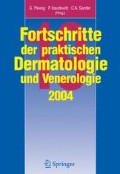Access this chapter
Tax calculation will be finalised at checkout
Purchases are for personal use only
Preview
Unable to display preview. Download preview PDF.
Literatur
Alcalay J, Landau M, Zucker A (2001) Analysis of laboratory data in acne patients treated with isotretinoin: is there really a need to perform routine laboratory tests? J Dermatol Treat 12: 9–12
Baxter KF, Ling TC, Barth JH, Cunliffe WJ (2003) Retrospective survey of serum lipids in patients receiving more than three courses of istoretinoin. J Dermatol Treat 14: 216–218
Bickers DR, Saurat JH (2001) Isotretinoin: a state-of-the-art conference. J Am Acad Dermatol 45: 125–128
Cunliffe WJ, van de Kerkhof PC, Caputo R, Caviccini S, Cooper A, Fyrand OL, Gollnick H, Layton AM, Leyden JJ, Mascaro JM, Ortonne JP, Shalita A (1997) Roaccutane treatment guidelines: results of an international survey. Dermatology 194: 351–357
Degitz K, Placzek M, Arnold B, Schmidt H, Plewig G (2001) Endokrinoloigsche Aspekte bei Akne. In: Plewig G, Degitz K (Hrsg) Fortschritte der praktischen Dermatologie und Venerologie 2000. Bd 17. Springer, Berlin, S 172–179
EMEA (2003) http://www.emea.eu.int/pdfs/human/refer-ral/isotretinoin/281103de1.pdf
EMEA (2003) http://www.emea.eu.int/pdfs/human/referral/isotretinoin/281103de.pdf
Ferahbas A, Turan MT, Esel E, Utas S, Kutlugun C, Kilic CG (2004) A pilot study evaluating anxiety and depressive scores in acne patients treated with isotretinoin. J Dermatol Treat 15: 153–175
Geißler SE, Michelsen S, Plewig G (2003) Very low dose isotretinoin is effective in controlling seborrhoea. JDDG 1:952–958
Goldsmith LA, Bolognia JL, Callen JP, Chen SC, Feldman SR, Lim HW, Lucky AW, Reed BR, Siegfried EC, Thiboutot DM, Wheeland RG (2004) American Academy of Dermatology Consensus Conference on the safe and optimal use of isotretinoin: summary and recommendations. J Am Acad Dermatol 50: 900–906
Harms M, Duvanel T, Williamson C, Masouyé I, Saurat JH (1989) Isotretinoin for acne: should we consider the total cumulative dose? In: Marks R, Plewig G (eds) Acne and related disorders. Dunitz, London, pp 203–206
Hersom K, Neary MP, Levaux HP, Klaskala W, Strass JS (2003) Isotretinoin and antidepressant pharmacotherapy: a prescription sequence symmetry analysis J Am Acad Dermatol 49: 424–433
Horting E, Paul E, Plewig G (1986) Treatment of rosacea with isotretinoin. Int J Dermatol 25: 660–663
Jacobs DG, Deutsch NL, Brewer M (2001) Suicide, depression, and isotretinoin: is there a causal link? J Am Acad Dermatol 45: 168–175
Jick SS, Kremers HM, Vasilakis-Scaramozza C (2000) Isotretinoin use and risk of depression, psychotic symptoms, suicide, and attempted suicide. Arch Dermatol 136: 1231–1236
Leyden JJ, McGinley KJ, Foglia AN (1986) Qualitative and quantitative changes in cutaneous bacteria associated with systemic isotretinoin therapy for acne conglobata. J Invest Dermatol 86: 390–393
Ling TC, Parkin G, Islam J, Seukeran DC, Cunliffe WJ (2001) What is the cumulative effect of long-term, low-dose isotretinoin on the development of DISH? Br J Dermatol 144: 630–632
Lowenstein EJ (2002) Isotretinoin made S.M.A.R.T.TM and simple. Cutis 70: 115–120
Meigel WN (1997) How safe is isotretinoin? Dermatology 195: 22–28
Meigel WM (2003) Retinoide und Depression: Ein Zusammenhang? In: Plewig G, Prinz J (Hrsg) Fortschritte der praktischen Dermatologie und Venerologie 2002. Bd 18. Springer, Berlin, S 214–217
Nau H (2001) Teratogenicity of isotretinoin revisited: species variation and the role of all-trans-retinoic acid. J Am Acad Dermatol 45: 183–187
Newton JN (1997) How cost-effective is oral isotretinoin? Dermatology 1951: 10–14
Palmer RA, Sidhu S, Googwin PG (2000) ‘Microdose’ isotretinoin. Br J Dermatol 143: 205–206
Plewig G (2003) Acne inversa, Acne keloidalis nuchae, abszedierende Follikulitis der Kopfhaut: Ein verbindendes Konzept. In: Plewig G, Prinz J (Hrsg) Fortschritte der praktischen Dermatologie und Venerologie 2002. Bd 18. Springer, Berlin, S 192–203
Plewig G, Dressel H, Pfleger M, Michelsen S, Kligman AM (2004) Low dose isotretinoin combined with tretinoin is effective to correct abnormalities of acne. JDDG 2: 31–45
Rohrback JM, Fleischer AB jr, Krowchuk DP, Feldman SR (2004) Depression is not common in isotretinoin-treated acne patients. J Dermatol Treat 15: 252
Simon G (1848) Die Hautkrankheiten durch anatomische Untersuchungen erläutert. Reimer, Berlin
Weissmann A, Wagner A, Plewig G (1981) Reduction of bacterial skin flora during treatment of severe acne with 13-cis-retinoic acid. Arch Dermatol Res 270: 179–183
Wysowski DK, Beitz J (2001) Comments and opinions, methodological limitations of the study “Isotretinoin use and risk of depression, psychotic symptoms, suicide, and attempted suicide”. Arch Dermatol 137: 1102–1103
Wysowski DK, Pitts M, Beiz J (2001) An analysis of reports of depression and suicide in patients treated with isotretinoin J Am Acad Dermatol 45: 515–519
Author information
Authors and Affiliations
Editor information
Rights and permissions
Copyright information
© 2005 Springer-Verlag Berlin Heidelberg
About this paper
Cite this paper
Plewig, G. (2005). Isotretinoin-Therapie: Wann, was, wie?. In: Plewig, G., Kaudewitz, P., Sander, C.A. (eds) Fortschritte der praktischen Dermatologie und Venerologie. Fortschritte der praktischen Dermatologie und Venerologie, vol 19. Springer, Berlin, Heidelberg. https://doi.org/10.1007/3-540-28691-8_38
Download citation
DOI: https://doi.org/10.1007/3-540-28691-8_38
Publisher Name: Springer, Berlin, Heidelberg
Print ISBN: 978-3-540-21055-9
Online ISBN: 978-3-540-28691-2
eBook Packages: Medicine (German Language)

